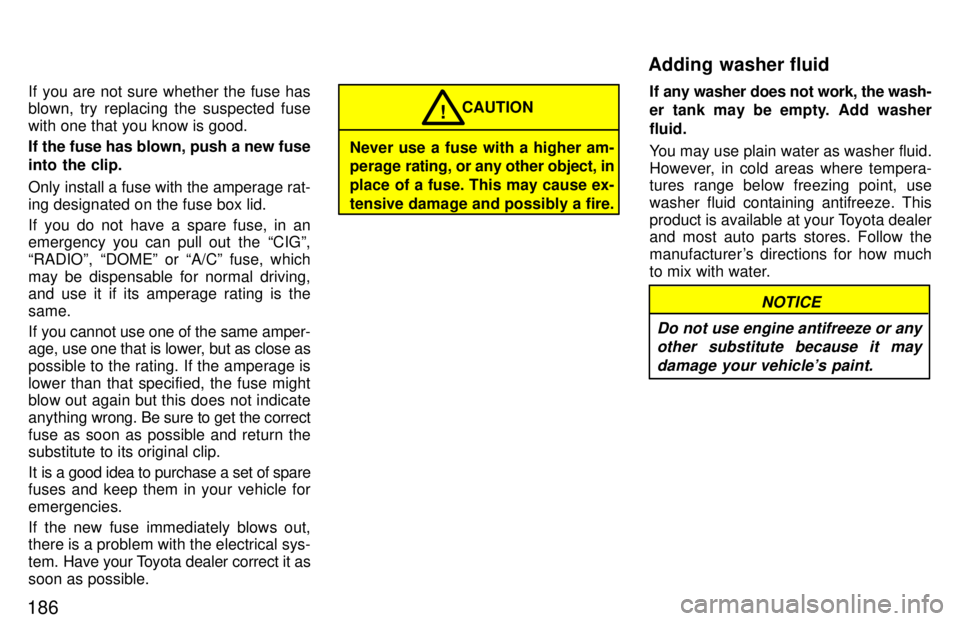fuse box TOYOTA T100 1997 Owners Manual
[x] Cancel search | Manufacturer: TOYOTA, Model Year: 1997, Model line: T100, Model: TOYOTA T100 1997Pages: 212, PDF Size: 3.17 MB
Page 189 of 212

185
NOTICE
Never recharge the battery while the
engine is running. Also, be sure all
accessories are turned off.
If the headlights or other electrical
components do not work, check the
fuses. If any of the fuses are blown,
they must be replaced.
See Fuse locationsº in Chapter 7-1 for
locations of the fuses.
Turn the ignition switch and inopera-
tive component off. Pull a suspected
fuse straight out and check it.
Determine wh ich fuse may be causing the
problem. The lid of the fuse box shows the name of the circuit for each fuse. See Part 8 of this manual for the functions con-
trolled by each circuit.
Type A fuses can be pulled out by the pull-
out tool.
Checking and replacing fuses
Page 190 of 212

186If you are not sure whether the fuse has
blown, try replacing the suspected fuse with one that you know is good.
If the fuse has blown, push a new fuse
into the clip.
Only install a fuse with the amperage rat-
ing designated on the fuse box lid.
If you do not have a spare fuse, in an
emergency you can pull out the CIGº,
RADIOº, DOMEº or A/Cº fuse, whichmay be dispensable for normal driving, and use it if its amperage rating is the same.
If you cannot use one of the same amper-
age, use one that is lower, but as close as
possible to the rating. If the amperage is
lower than that specified, the fuse might
blow out again but this does not indicate
anything
wrong. Be sure to get the correct
fuse as soon as possible and return the
substitute to its original clip.
It is a good idea to purchase a set of spare
fuses and keep them in your vehicle for emergencies.
If the new fuse immediately blows out, there is a problem with the electrical sys-
tem. Have your Toyota dealer correct it as
soon as possible.
Never use a fuse with a higher am-
perage rating, or any other object, in
place of a fuse. This may cause ex-
tensive damage and possibly a fire. CAUTION
!
If any washer does not work, the wash-
er tank may be empty. Add washer fluid.
You may use plain water as washer fluid.
However, in cold areas where tempera-
tures range below freezing point, use
washer fluid containing antifreeze. This
product is available at your Toyota dealer
and most auto parts stores. Follow the
manufacturer 's directions for how much
to mix with water.
NOTICE
Do not use engine antifreeze or any other substitute because it may
damage your vehicle's paint.
Adding washer fluid
Page 204 of 212

200
Fuses (type A)
1. HEAD (LH) 10 A: Left-hand headlight
2. HEAD (RH) 10 A: Right-hand head-
light
3. A/C 10 A: Air conditioning cooling sys-
tem
4 EFI 15 A: Multiport fuel injection sys-
tem/sequential multiport fuel injection
system, electronically controlled auto-
matic transmission system
5. HAZ-HORN 15 A: Emergency flash-
ers, horns
6. DOME 15 A: Interior light, personal
lights, step lights, ignition switch light,
radio, cassette tape player, power an- tenna, clock7. HEAD (LH-HI) 10 A: Left-hand head-
light (high beam)
8. HEAD (RH-HI) 10 A: Right-hand
headlight (high beam)
9. HEAD (LH-LO) 10 A: Left-hand
headlight (low beam)
10. HEAD (RH-LO) 10 A: Right-hand
headlight (low beam)
11. ENGINE 10 A: Charging system,
cruise control system
12. IGN. 7.5 A: Charging system,
discharge warning light, multiport fuel
injection system/sequential multiport fuel injection system13. TAIL 15 A: Tail lights, parking lights,
license plate lights, instrument panel lights, glovebox light
14. WIPER 20 A: Windshield wiper and
washer
15. GAUGES 10 A: Automatic transmis-
sion overdrive control system, gauges
and meters, service reminder indica-
tors and warning buzzers (except dis-
charge cruise warning light), A.D.D. control system, cruise control system,
back-up lights, power door lock sys- tem
16. STOP 15 A: Stop lights, High-
mounted stoplight, cruise control sys-
tem, electronically controlled automat-
ic transmission system
Fuses